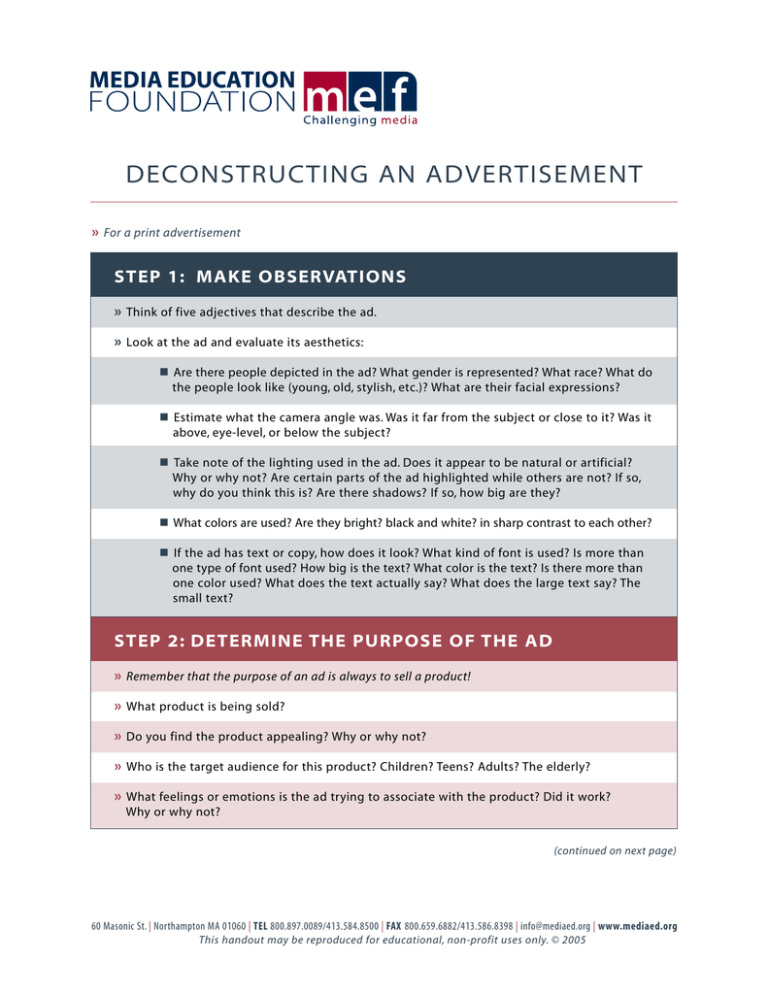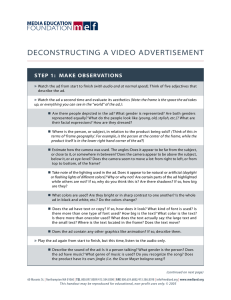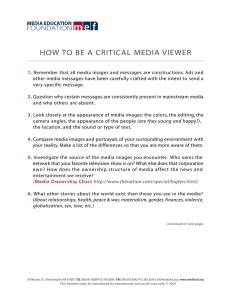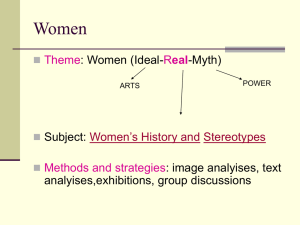DECONSTRUCTING AN ADVERTISEMENT STEP 1: MAKE OBSERVATIONS »
advertisement

DECONSTRUCTING AN ADVERTISEMENT » For a print advertisement STEP 1: MAKE OBSERVATIONS » Think of five adjectives that describe the ad. » Look at the ad and evaluate its aesthetics: Are there people depicted in the ad? What gender is represented? What race? What do the people look like (young, old, stylish, etc.)? What are their facial expressions? Estimate what the camera angle was. Was it far from the subject or close to it? Was it above, eye-level, or below the subject? Take note of the lighting used in the ad. Does it appear to be natural or artificial? Why or why not? Are certain parts of the ad highlighted while others are not? If so, why do you think this is? Are there shadows? If so, how big are they? What colors are used? Are they bright? black and white? in sharp contrast to each other? If the ad has text or copy, how does it look? What kind of font is used? Is more than one type of font used? How big is the text? What color is the text? Is there more than one color used? What does the text actually say? What does the large text say? The small text? STEP 2: DETERMINE THE PURPOSE OF THE AD » Remember that the purpose of an ad is always to sell a product! » What product is being sold? » Do you find the product appealing? Why or why not? » Who is the target audience for this product? Children? Teens? Adults? The elderly? » What feelings or emotions is the ad trying to associate with the product? Did it work? Why or why not? (continued on next page) 60 Masonic St. | Northampton MA 01060 | TEL 800.897.0089/413.584.8500 | FAX 800.659.6882/413.586.8398 | info@mediaed.org | www.mediaed.org This handout may be reproduced for educational, non-profit uses only. © 2005 DECONSTRUCTING AN ADVERTISEMENT (continues from other page) STEP 3: DETERMINE THE ASSUMPTIONS THE AD MAKES & THE MESSAGES IT SENDS » Assumptions may not be contained directly in the ads themselves, but in the messages that are produced from them What assumptions does the ad make about gender? (i.e. Women are powerful when they hold a hair dryer in their hands. Men like to drink beer. Women are primary caregivers, etc..) Are these assumptions realistic? Why or why not? Do these assumptions reinforce or challenge stereotypes about gender identity? What assumptions does the ad make about race (i.e. African Americans are excellent athletes. Latinos are sensual and passionate. Etc.)? Are these assumptions realistic? Why or why not? Do these assumptions reinforce or challenge stereotypes about racial identity? What assumptions does the ad make about class (i.e. Wealthy people are happy and trouble-free. Poor people are always looking for a handout, etc..)? Are these assumptions realistic? Why or why not? Do these assumptions reinforce or challenge stereotypes about class? STEP 4: CONSIDER THE POSSIBLE CONSEQUENCES OF THESE MESSAGES » What are some possible consequences? (long-term and short-term) » Do the messages create unrealistic expectations for people? Why or why not? » How do the messages in this ad counter or undermine social change? » Is this ad socially responsible? How or how not? What does it mean for an ad or a company to be socially responsible? » In the closing comments of the video Killing Us Softly 3, Jean Kilbourne states that change will depend upon “an aware, active, educated public that thinks for itself primarily as citizens rather than primarily as consumers.” What does it mean to think of oneself primarily as a citizen rather than primarily a consumer? Can one be both a citizen and a consumer? How? Reflect on this ad with the above statement in mind. 60 Masonic St. | Northampton MA 01060 | TEL 800.897.0089/413.584.8500 | FAX 800.659.6882/413.586.8398 | info@mediaed.org | www.mediaed.org This handout may be reproduced for educational, non-profit uses only. © 2005








